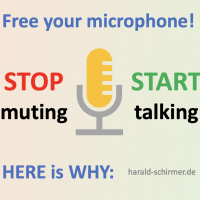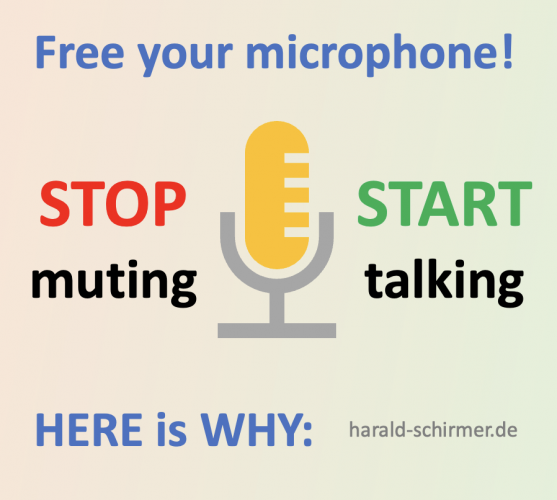
On my mission to improve virtual and hybrid work: Stop MUTING, Start Talking!
Ever asked yourself,
why there is this strange silence
and little participation
in virtual meetings?
Before Covid, when many had little technical skills 😉 we learned that muting our microphones prohibits echo and ugly noises. During Lockdowns, we had the chance to learn, how virtual communication works, how important a good camera and lightening is, that a decent microphone dramatically enhances, how your messages come across.
New Work, Hybrid Work – virtual calls, meetings or conferences will stay. But shouldn’t we re-think our behavior, as one common issue in non-physical meetings is the lack of engagement, missing „vibrant“ discussions and an „natural“ atmosphere?
In our research and experimenting we found one important reason for that – and once this is changed, our virtual meetings became a lot better!
If you start your meeting with this:

it feels a bit like someone welcomes you with „SHUT UP – I don’t want to hear you/don’t disturb me!“ At least it is a clear message, not to actively take part, as there is a big fear of ?
Demanding muted microphones
might cause demotivation
Of course there are reasons for muting everyone, but then it would be recommended to use a „Broadcast“ session, where only the speaker can talk. For meetings, workshops or participative events, I would highly recommend, not to demotivate people by demanding „silence“. In the end, this is what I get – disconnected people in listening mode.
We tried: „PLEASE UNMUTE as default“
in many different meetings, workshops and events
and this is what happened:

More lively discussions and engagement
By more people being constantly unmuted, replying to ones question, interacting with each other or even asking something in between became a lot more natural. The time typically needed, to grab the mouse, move it to the unmute button, wait for the software to really unmute – was too long – often resulting in a delay, where the question or contribution did not perfectly fit anymore. Since we remained unmuted, discussions got a good flow – which built trust and a much higher engagement level.
Less „can you hear me?“
By being mostly unmuted, there is no reason to ask, if one can hear you, as you had a chat already in the beginning (the vital informal exchange, when entering a new (virtual) room). Having the confidence, that your audio is always available, makes exchange so much more fluent.
Sharing a common space
We realized that in physical meetings, it is never „completely silent“. There are shallow noises like breathing, scratches, a fan, a car driving by or someone typing – taking notes. The complete absence of any noise – for both, audience and speaker – feels (unconsciously) for many strange, lonely, left out, unnatural.
By unmuting the microphones (except it is really loud or disturbing), the audio-atmosphere helped feeling being together with other humans and less isolated.
More relevance and efficiency
If we give people the chance and even promote using their voice – we get… feedback. By open microphones, the hurdle to speak up is lower, so if someone needs clarification, has a question or wants to offer personal perspectives, they can just naturally talk – without dealing with software, delays, bandwidth or thinking about „technology“.
The result, we could clarify a lot more IN the meetings, which saved time clarifying things after it, or even eliminating additional meetings.
One might argue, that it is more efficient, if there is no discussion (some even find the chat disturbing), but if people do not understand your point, abbreviation or reference to something, they don’t know – you will not get commitment, resulting in extra rounds.
Group dynamics
Video calls are (other than in Virtual Reality) are limited to one discussion only. But by unmuted microphones this one conversation can have many participants – in high dynamic, giving the group/team/department a better feeling of togetherness and sense of belonging. If lines are all muted – discussions are often very sequential with waiting space and excuses or delays. „We can’t hear you“, „You are still muted“ 😉
„You are still muted,
…kills a deep conversation
we can’t hear you ;-)“
In case of bad noise
Of course not every noise is creating a better atmosphere, once it is too loud, in most tools, everyone can mute other participants or even mute „all“ (very fast) and than, giving a short info why you did mute all, asking the participants to unmute again. If we become more mature in using our technology and reducing hurdles of communication and collaboration, we can make virtual and hybrid work much better.
good microphones
are key, too!
The very small investment in good microphones can not be underestimated when it comes to focus (where we spend our brain power on: trying to understand bad audio, or focussing on content)
Bonus Tip: Shortcuts
As a compromise, many video-conferencing tools offer the assignment of a keyboard key to unmute (like the space key) – that is also a good solution in noisy environments (like a coffee or shop floor area) to still be fast and interactive, but not causing too much noise.
Bonus Tip: Noise Compression
Experiences with „Walk & Talk“ meetings showed that by using the noise compression in the tools is also VERY helpful already – that filters out almost all „non verbal“ sounds, like wind, cars, sometimes even other people talking in background.
Bonus Tip: Music
Don’t underestimate the power of music and sounds (like clapping, cheering…) for waiting time, celebrating, team building in virtual calls. For this make sure that your audio source is shared with the screen you are presenting or connected via an audio mixer to your microphone.
Important here: turn off the noise compression, so „everything“ you feed into the microphone channel, goes through – unfiltered. This ensures best audio-quality.
Digital maturity becomes visible by our professional use of tools, methods, formats and reflected behavior. In physical meetings, our suit, shoes or tie made a (good) first impression. In virtual calls, it is our audio and video appearance and the virtuosity playing or role modeling, which builds our reputation. Be brave, try out new things, question status quo and establish what you are missing (breaks, informal exchange, team building, getting to know each other….)
It’s not a question
IF we can build trust or engagement in virtual rooms,
but HOW to improve it!
I hope this was helpful – I would love to read your comments, and experience you can share to improve Virtual and Hybrid Work!

Schreibe einen Kommentar